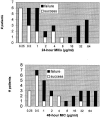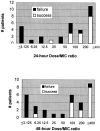Fluconazole MIC and the fluconazole dose/MIC ratio correlate with therapeutic response among patients with candidemia
- PMID: 16048920
- PMCID: PMC1196236
- DOI: 10.1128/AAC.49.8.3171-3177.2005
Fluconazole MIC and the fluconazole dose/MIC ratio correlate with therapeutic response among patients with candidemia
Abstract
We tested 32 Candida isolates recovered in the early 1990s from the bloodstreams of patients with candidemia for in vitro susceptibility to fluconazole and determined if MIC and/or the daily dose of fluconazole/MIC ratio correlated with the response to therapy. This is a unique data set since 87.5% (28/32) of patients were treated with fluconazole doses now considered to be inadequate (</=200 mg), which contributed to high therapeutic failure rates (53% [17/32]). The geometric mean MIC and dose/MIC ratio for isolates associated with therapeutic failure (11.55 mug/ml and 14.3, respectively) differed significantly from values associated with therapeutic success (0.95 mug/ml and 219.36 [P = 0.0009 and 0.0004, respectively]). The therapeutic success rates among patients infected with susceptible (MIC </= 8 mug/ml), susceptible-dose dependent (S-DD) (MIC = 16 or 32 mug/ml), and resistant (MIC >/= 64 mug/ml) isolates were 67% (14/21), 20% (1/5), and 0% (0/6), respectively. A dose/MIC ratio >50 was associated with a success rate of 74% (14/19), compared to 8% (1/13) for a dose/MIC ratio </=50 (P = 0.0003). Our data suggest that both fluconazole MIC and dose/MIC ratio correlate with the therapeutic response to fluconazole among patients with candidemia. In clinical practice, dose/MIC ratio might prove easier to interpret than breakpoint MICs, since it quantitates the effects of increasing fluconazole doses that are alluded to in the S-DD designation.
Figures
References
-
- Arikan, S., and J. H. Rex. 2000. New agents for treatment of systemic fungal infections. Emerg. Drugs 5:135-160. - PubMed
Publication types
MeSH terms
Substances
LinkOut - more resources
Full Text Sources



